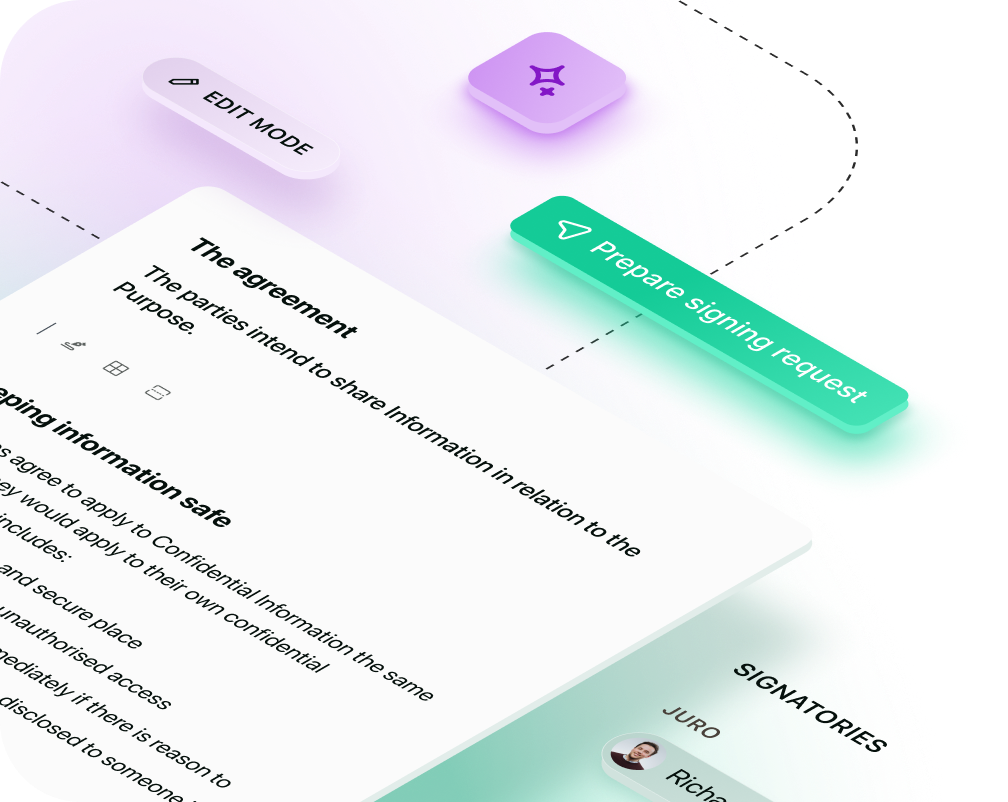Solutions
Customer Support
Resources
Download your free training reimbursement agreement template and streamline your contract creation process.




When businesses invest in their employees' development, it's crucial to protect that investment. A training reimbursement agreement ensures that companies can recoup costs if an employee leaves shortly after receiving expensive training.
This article explores the ins and outs of training reimbursement agreements, offering a comprehensive guide on creating and managing them effectively. We'll also look at how Juro’s AI-driven contract automation platform can streamline the process.
A training reimbursement agreement is a contract between an employer and an employee. It stipulates that the employee must repay the cost of their training if they leave the company within a specified period. This type of business contract helps businesses safeguard their investment in employee development.
The primary purpose of a training reimbursement agreement is to protect a company's investment in employee training.
Key objectives include cost recovery, ensuring the company can recoup training expenses if the employee leaves prematurely, and employee retention, encouraging employees to stay with the company for a longer period.
A training reimbursement agreement also provides clear obligations and conditions regarding training investments and repayment terms.
Training reimbursement agreements are typically managed by several key departments within an organization:
Human Resources (HR) often oversees training programs and is responsible for managing agreements related to employee development and training reimbursements. They handle the administration of policies, approval processes, and compliance.
The finance team might manage the financial aspects of training reimbursement, including budgeting, processing reimbursements, and ensuring that payments align with company policies.
The legal team might be involved in drafting and reviewing training reimbursement agreements to ensure they comply with relevant laws and regulations and protect the company's interests.
In organizations with a dedicated training and development team, this group might manage the implementation and tracking of training programs and reimbursements.
Each department's involvement can vary based on the organization's size, structure, and specific policies.

Training reimbursement contracts are typically used in the following situations:
Employee development programs: When a company invests in the professional development of its employees by funding courses, certifications, or degree programs, a reimbursement contract ensures that the employee remains with the company for a specified period or repays the training costs if they leave early.
Skill enhancement and upgrading: For roles requiring continuous education to keep up with industry standards or new technologies, companies may fund training programs and use reimbursement contracts to safeguard their investment.
Onboarding and new hire training: When new employees require specific training as part of their onboarding process, companies may use reimbursement contracts to ensure that the cost of training is recouped if the employee leaves shortly after completing the training.
Compliance and regulatory training: In industries where specific training is mandatory for compliance with laws and regulations, companies may cover the cost and use reimbursement contracts to manage the financial risk associated with employee turnover.
Leadership and management training: For employees selected for advanced leadership or management programs, reimbursement contracts can ensure that the company's investment in future leaders is protected.
Specialized training programs: For niche or highly specialized training that is costly and not widely available, reimbursement agreements ensure that the company benefits from the employee's newly acquired skills for a reasonable period.
These contracts help mitigate the risk of employees leaving the company shortly after receiving expensive training, thereby protecting the company's investment in its workforce.
.avif)
A comprehensive training reimbursement agreement template should cover the following elements:
1. Introduction
2. Training details
3. Costs and reimbursement
4. Employment terms
5. Data privacy
6. Liability and indemnification
7. Governing law and dispute resolution
8. Miscellaneous provisions
Managing training reimbursement agreements involves several steps:

Managing training reimbursement agreements manually can be challenging for the following reasons:
Juro’s AI-native contract automation platform offers a solution to these challenges, empowering HR and legal teams to manage training reimbursement agreements efficiently. Here’s how Juro can help:
Enable HR teams to create and manage agreements independently, reducing reliance on the legal team and speeding up the process.
Streamline the drafting, approval, and execution of agreements with AI-driven tools, ensuring faster turnaround times and improved operational efficiency.
Store all agreements in a secure, central location. This ensures easy access and better risk management, avoiding missed deadlines or non-compliance issues.
Facilitate seamless collaboration across HR, legal, and other teams in a single workspace. Improve communication and ensure everyone is on the same page.
Gain valuable insights into contract performance, risks, and opportunities. Use this data to make informed decisions and optimise your contract management processes.

Juro’s AI-native contract automation platform empowers all teams to create, agree, execute and manage contracts up to 10x faster than traditional tools. To find out more, hit the button below to book your personalized demo.
Juro is the #1-rated contract platform globally for speed of implementation.


Juro embeds contracting in the tools business teams use every day, so they can agree and manage contracts end-to-end - while legal stays in control.
Book your demo